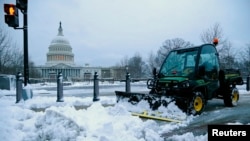After a mild start, winter is about to make itself felt along the eastern United States at the end of this week.
Forecasters say a major winter snowstorm could affect tens of millions of people from Kentucky through New England late Friday through Sunday.
Most forecasters are not calling this a historic storm. But they say the various forecast models and readings that frequently disagree on the path of big storms all concur that it will be strong, coming up the Atlantic Coast and pulling in tons of moisture.
Some areas could get 61 centimeters (about 2 feet) of snow or more.
Because the storm is likely to hit after the traditional Monday through Friday workweek is over, the effect on schools and businesses is expected to be minimal, but travel will be difficult.
Although it's still early, computer forecast models all see a windy, strong, slow-moving storm. The big questions are where it will hit and how much moisture it will bring.
Rich Otto, lead forecaster at the National Weather Service's Weather Prediction Center outside Washington, said Tuesday that an upper-level disturbance in the air is moving from the Pacific Ocean to the Rockies to the Southern Plains. It should pass over Texas, hit the Ohio Valley, join with other unstable air and become a "nor'easter" Friday evening over the Mid-Atlantic, then move up the coast Saturday.
A nor'easter gets its name from the northeasterly winds that blow in from the ocean ahead of the storm. These storms form along the U.S. East Coast as warm air from over the Atlantic Ocean clashes with arctic cold to the north and west.
Forecasters expect strong winds, beach erosion and possible flooding in the affected areas.
However, this storm is days from starting, which means there is still time for forecasts to shift.












